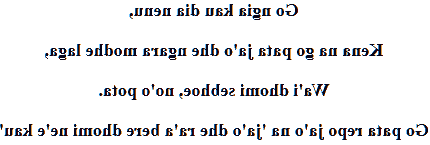Bajawa Ngad'a love poem
Nenu
Go ngia kau dia nenu,
Kena na go pata ja'o dhe ngara modhe laga,
Wa'i dhomi sebhoe, no'o pota.
Go pata repo ja'o na 'ja'o dhe ra'a bere dhomi ne'e kau'


→ French poem ←
Ngad'a language
Love poem translated into Ngad'a of Bajawa (Ngad'a, Bajawa, Central Ngada, Badjava, Ngadha, Rokka, Nga'da, Ngada Ngadha, Nad'a, South Ngada, Ngada, Bajava).
Most Indonesians use the local language as their first language. The use of regional languages on the island of Flores, and in the Ngada region where Bajawa is spoken is not an exception, it is daily used.
This Austronesian language, Mayalo-Polynesian, is spoken in Indonesia on the island of Flores in the Kabupaten of Ngada. This translation comes from Bajawa the capital.
The particularity of Ngad'a is that it has no prefix or suffix. It is a Bima Sumba language, that speak in total perhaps 65,000 speakers if we include all those of the two Ngadha dialects.
Ngadha, like the other languages of Flores, is a specifically an oral language, its history has not been documented, and one can just try to hypothesize.
If the historical study of the region began in the 16th century, when the Europeans arrived, the research undertaken remained quite rare.
To be able to formulate hypotheses, it should be remembered: In 2004 will be discovered on the island of Flores, skeletons of very small hominids, dating back more than 12,000 years. (Homo floresiensis).
It is also established that the Nages, describe in their traditions, small hairy creatures (Ebu gogo), but which were still present at a much less distant time; since that would be just over two hundred years ago. These Ebu gogo (wild men), lived in areas close to theirs, without interacting with them, except to steal them, and would have ended up being exterminated; something important is to note : the oral tradition describes them as having the ability to speak.
All the languages of Flores are not isolated, but become more and more isolating when one gets closer to the center of the island, this is an important distinction concerning the central Flores languages.
It is also clear that the famous skeletons were discovered exactly where these languages are spoken, and where the oral tradition is the most alive to transmit the stories relating to Ebu gogo.
Ngad'a, like the other languages of central Flores, also has many characteristics, which suggest how it's an old language age; and in many ways the contrast is important with the other Austronesian languages.
Some of its characteristics, in comparison with other known cases, suggest by linguists that Ngad'a would have been a language simplified by its learning by adults. (John McWhorter, Columbia University).
When the Austronesians first settled in the eastern part of Indonesia, during their migration to Flores, would they not have learned as a kind of pidgin, the languages of those they met by replacing them and by marrying their wives, to communicate with them; perhaps? Here is a hypothesis!
If it is not those of this first wave, perhaps it happened, 3,000 years ago, with another wave of Austronesian migrants, who left Sulawesi, to go to Flores.
In any case, by researching genetics, it does seem that the male population of Flores has been replaced by a population of new male emigrants.
Epilogue
For me who took some interest to prehistory, the man of Flores remains a bit of an enigma, and his specificities are surely linked to his insular isolation.
I hope that my poem will make you desire to learn this Austronesian language, to bring it to life, and to meet the prettiest girls from this province, because now you will be able to tell them "I love you" in their language!